BSBMGT605B: Leadership Styles, Interpersonal Skills, and Development
VerifiedAdded on 2023/06/12
|8
|1874
|461
Report
AI Summary
This assignment provides an analysis of leadership and interpersonal styles relevant for a senior manager role. It explores various leadership styles, including participative, contingency, autocratic, facilitative, democratic, and charismatic leadership, recommending charismatic leadership for the new role. The report also discusses interpersonal styles such as aggressive, passive, and assertive, advocating for the assertive style to foster open communication. Furthermore, it assesses the skills required for the role, including interpersonal, communication, analytical, creative, influencing, teamwork, organizational, IT, business acumen, and drive, rating the author's proficiency in each area. Finally, it identifies professional development opportunities like upgrading skills, participating in events, organizational memberships, and team-building workshops, outlining specific courses and activities for improvement. Desklib offers a wealth of similar student-contributed documents and AI-powered study tools to aid in academic success.
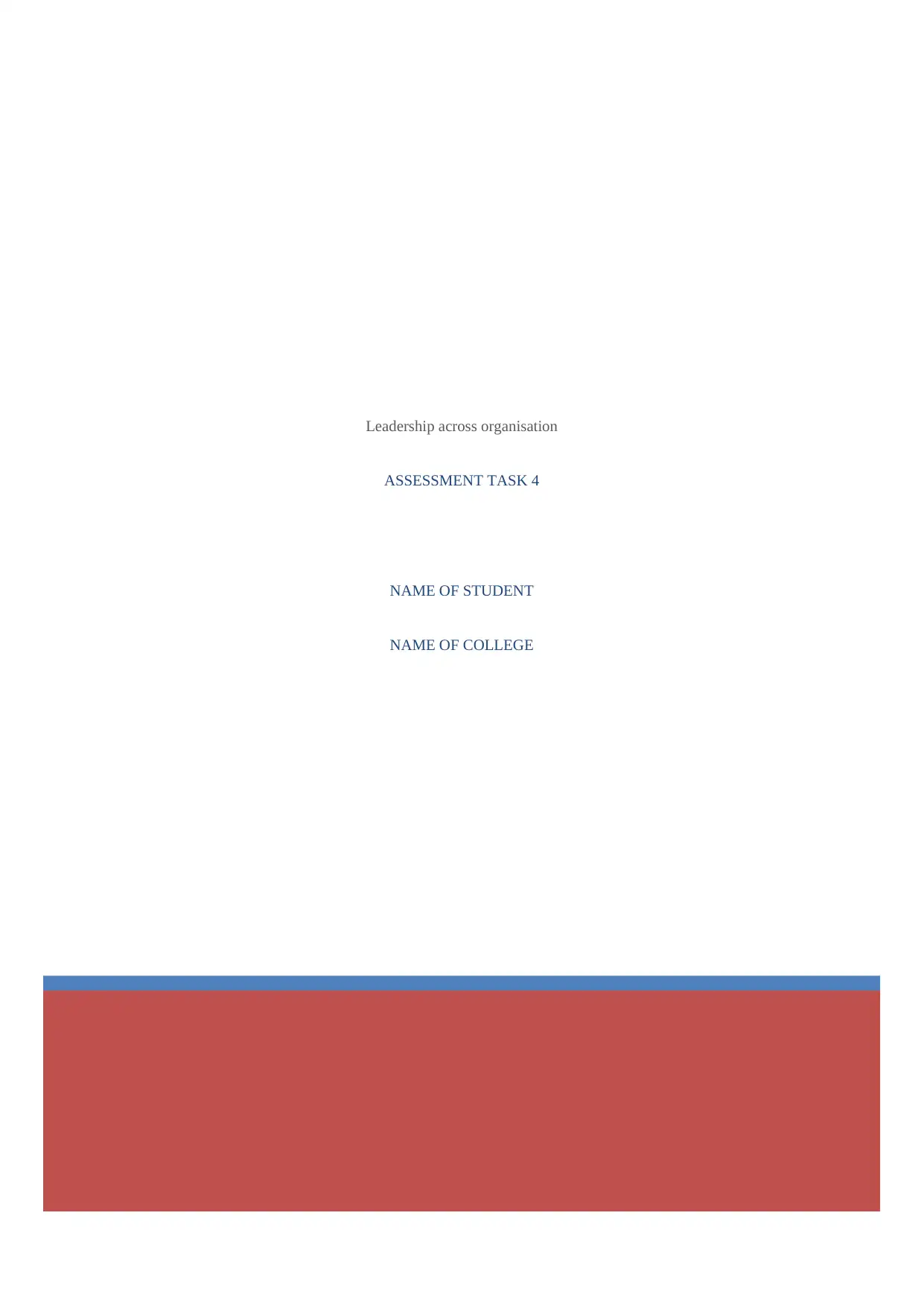
Leadership across organisation
ASSESSMENT TASK 4
NAME OF STUDENT
NAME OF COLLEGE
ASSESSMENT TASK 4
NAME OF STUDENT
NAME OF COLLEGE
Paraphrase This Document
Need a fresh take? Get an instant paraphrase of this document with our AI Paraphraser

Professional development plan
Following are the different leadership styles:
1. Participative Leadership- Participative leadership is a leadership style which
invites inputs from all the employees of an organization regarding all or most
company decisions (Holten and Brenner 2015). In this leadership style the
staffs of the company is provided with relevant information regarding various
company issues and a majority vote helps in determining the course of action
to be taken by the company.
2. Contingency leadership- The contingency style of leadership implies that a
leader will adopt a leadership depending upon the demand of the situation as
there is no single leadership style which is suitable for all situations (Li, et al.
2016). The contingency theory of leadership states that the effectiveness of a
leader is contingent upon with regarding how their leadership style matches
with the situation.
3. Autocratic Leadership style- Autocratic leadership is a management style in
which on person who acts as the leader controls all the decisions which are
taken in a group or an organization and takes very little or no inputs from the
other group members. (Holten and Brenner 2015).
4. Facilitative Leadership- Facilitative leadership is defined as a people-centric,
quality driven and result driven process of developing and supporting a culture
in the workplace which facilitates goal achievement through effective
relational processes.
5. Democratic Leadership style- Democratic leadership is also defined as
participative leadership in which the members of the group take a more
participative role in the decision-making process of the group and every
member of the group is provided the opportunity to provide their inputs while
reaching to a decision (Nawaz and Khan 2016).
6. Charismatic Leadership- Charismatic leadership is basically defined as the
method of encouraging particular behaviors in other people through eloquent
communication, persuasion and force of personality(Li, et al. 2016).
1
Following are the different leadership styles:
1. Participative Leadership- Participative leadership is a leadership style which
invites inputs from all the employees of an organization regarding all or most
company decisions (Holten and Brenner 2015). In this leadership style the
staffs of the company is provided with relevant information regarding various
company issues and a majority vote helps in determining the course of action
to be taken by the company.
2. Contingency leadership- The contingency style of leadership implies that a
leader will adopt a leadership depending upon the demand of the situation as
there is no single leadership style which is suitable for all situations (Li, et al.
2016). The contingency theory of leadership states that the effectiveness of a
leader is contingent upon with regarding how their leadership style matches
with the situation.
3. Autocratic Leadership style- Autocratic leadership is a management style in
which on person who acts as the leader controls all the decisions which are
taken in a group or an organization and takes very little or no inputs from the
other group members. (Holten and Brenner 2015).
4. Facilitative Leadership- Facilitative leadership is defined as a people-centric,
quality driven and result driven process of developing and supporting a culture
in the workplace which facilitates goal achievement through effective
relational processes.
5. Democratic Leadership style- Democratic leadership is also defined as
participative leadership in which the members of the group take a more
participative role in the decision-making process of the group and every
member of the group is provided the opportunity to provide their inputs while
reaching to a decision (Nawaz and Khan 2016).
6. Charismatic Leadership- Charismatic leadership is basically defined as the
method of encouraging particular behaviors in other people through eloquent
communication, persuasion and force of personality(Li, et al. 2016).
1
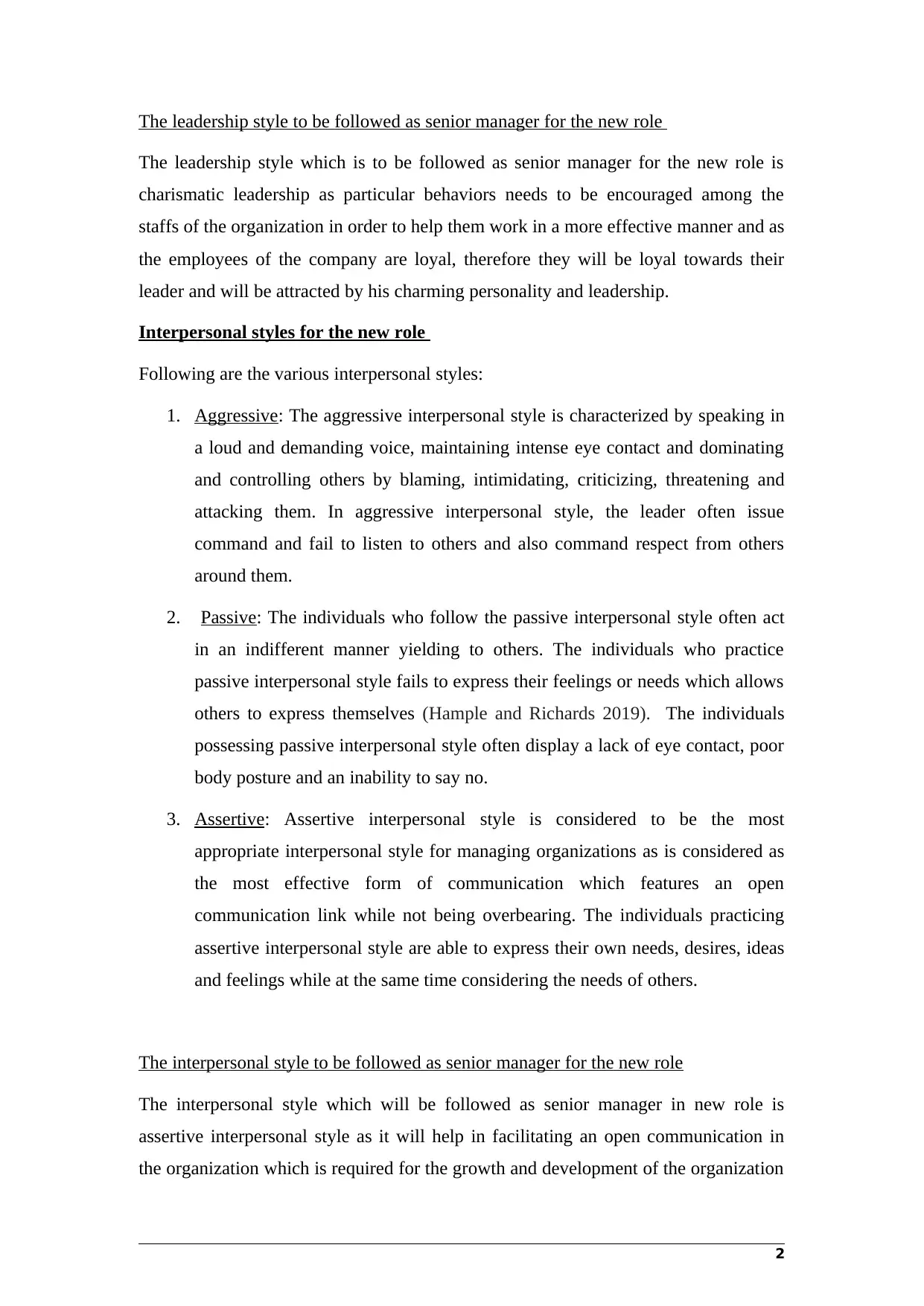
The leadership style to be followed as senior manager for the new role
The leadership style which is to be followed as senior manager for the new role is
charismatic leadership as particular behaviors needs to be encouraged among the
staffs of the organization in order to help them work in a more effective manner and as
the employees of the company are loyal, therefore they will be loyal towards their
leader and will be attracted by his charming personality and leadership.
Interpersonal styles for the new role
Following are the various interpersonal styles:
1. Aggressive: The aggressive interpersonal style is characterized by speaking in
a loud and demanding voice, maintaining intense eye contact and dominating
and controlling others by blaming, intimidating, criticizing, threatening and
attacking them. In aggressive interpersonal style, the leader often issue
command and fail to listen to others and also command respect from others
around them.
2. Passive: The individuals who follow the passive interpersonal style often act
in an indifferent manner yielding to others. The individuals who practice
passive interpersonal style fails to express their feelings or needs which allows
others to express themselves (Hample and Richards 2019). The individuals
possessing passive interpersonal style often display a lack of eye contact, poor
body posture and an inability to say no.
3. Assertive: Assertive interpersonal style is considered to be the most
appropriate interpersonal style for managing organizations as is considered as
the most effective form of communication which features an open
communication link while not being overbearing. The individuals practicing
assertive interpersonal style are able to express their own needs, desires, ideas
and feelings while at the same time considering the needs of others.
The interpersonal style to be followed as senior manager for the new role
The interpersonal style which will be followed as senior manager in new role is
assertive interpersonal style as it will help in facilitating an open communication in
the organization which is required for the growth and development of the organization
2
The leadership style which is to be followed as senior manager for the new role is
charismatic leadership as particular behaviors needs to be encouraged among the
staffs of the organization in order to help them work in a more effective manner and as
the employees of the company are loyal, therefore they will be loyal towards their
leader and will be attracted by his charming personality and leadership.
Interpersonal styles for the new role
Following are the various interpersonal styles:
1. Aggressive: The aggressive interpersonal style is characterized by speaking in
a loud and demanding voice, maintaining intense eye contact and dominating
and controlling others by blaming, intimidating, criticizing, threatening and
attacking them. In aggressive interpersonal style, the leader often issue
command and fail to listen to others and also command respect from others
around them.
2. Passive: The individuals who follow the passive interpersonal style often act
in an indifferent manner yielding to others. The individuals who practice
passive interpersonal style fails to express their feelings or needs which allows
others to express themselves (Hample and Richards 2019). The individuals
possessing passive interpersonal style often display a lack of eye contact, poor
body posture and an inability to say no.
3. Assertive: Assertive interpersonal style is considered to be the most
appropriate interpersonal style for managing organizations as is considered as
the most effective form of communication which features an open
communication link while not being overbearing. The individuals practicing
assertive interpersonal style are able to express their own needs, desires, ideas
and feelings while at the same time considering the needs of others.
The interpersonal style to be followed as senior manager for the new role
The interpersonal style which will be followed as senior manager in new role is
assertive interpersonal style as it will help in facilitating an open communication in
the organization which is required for the growth and development of the organization
2
⊘ This is a preview!⊘
Do you want full access?
Subscribe today to unlock all pages.

Trusted by 1+ million students worldwide
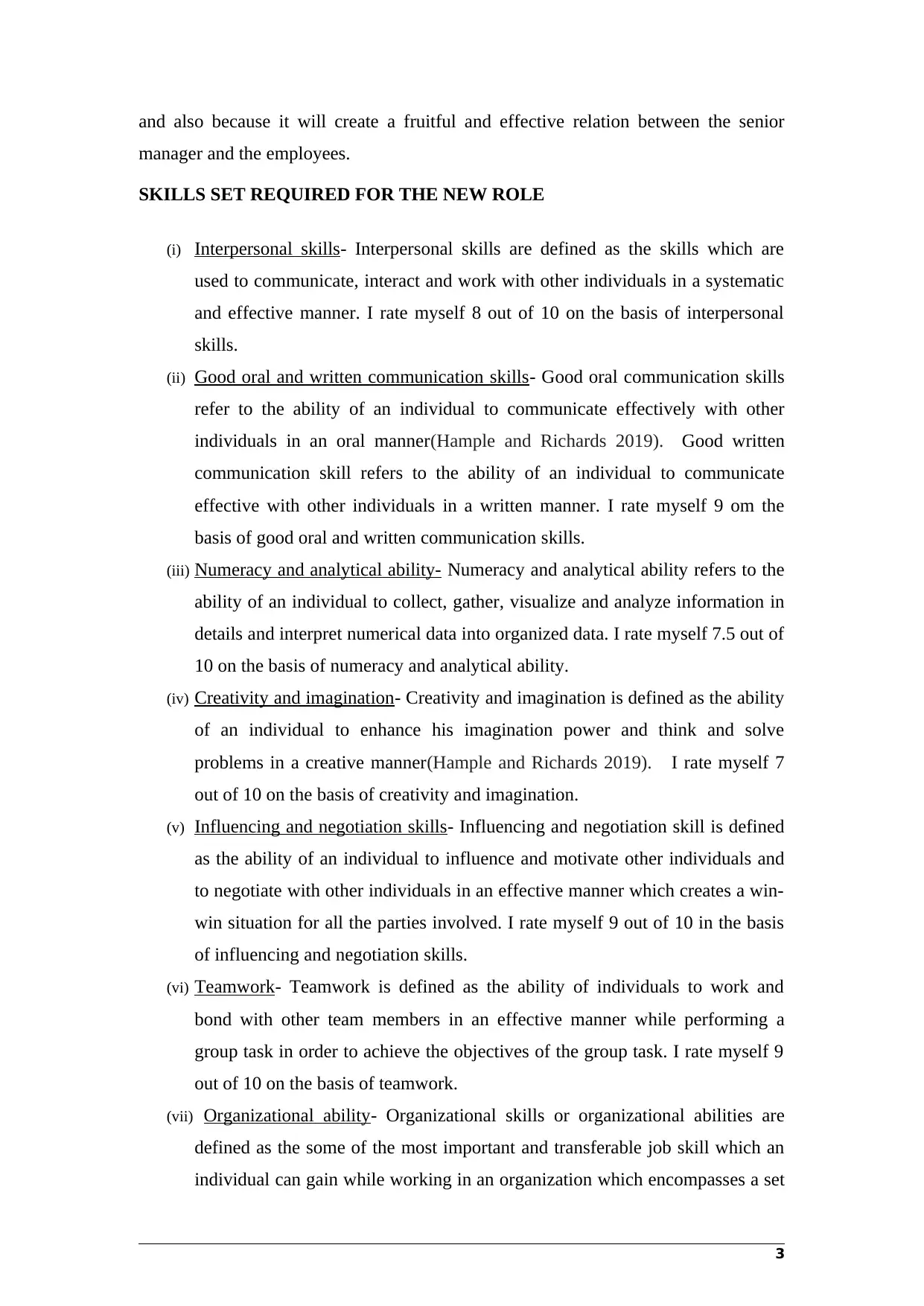
and also because it will create a fruitful and effective relation between the senior
manager and the employees.
SKILLS SET REQUIRED FOR THE NEW ROLE
(i) Interpersonal skills- Interpersonal skills are defined as the skills which are
used to communicate, interact and work with other individuals in a systematic
and effective manner. I rate myself 8 out of 10 on the basis of interpersonal
skills.
(ii) Good oral and written communication skills- Good oral communication skills
refer to the ability of an individual to communicate effectively with other
individuals in an oral manner(Hample and Richards 2019). Good written
communication skill refers to the ability of an individual to communicate
effective with other individuals in a written manner. I rate myself 9 om the
basis of good oral and written communication skills.
(iii) Numeracy and analytical ability- Numeracy and analytical ability refers to the
ability of an individual to collect, gather, visualize and analyze information in
details and interpret numerical data into organized data. I rate myself 7.5 out of
10 on the basis of numeracy and analytical ability.
(iv) Creativity and imagination- Creativity and imagination is defined as the ability
of an individual to enhance his imagination power and think and solve
problems in a creative manner(Hample and Richards 2019). I rate myself 7
out of 10 on the basis of creativity and imagination.
(v) Influencing and negotiation skills- Influencing and negotiation skill is defined
as the ability of an individual to influence and motivate other individuals and
to negotiate with other individuals in an effective manner which creates a win-
win situation for all the parties involved. I rate myself 9 out of 10 in the basis
of influencing and negotiation skills.
(vi) Teamwork- Teamwork is defined as the ability of individuals to work and
bond with other team members in an effective manner while performing a
group task in order to achieve the objectives of the group task. I rate myself 9
out of 10 on the basis of teamwork.
(vii) Organizational ability- Organizational skills or organizational abilities are
defined as the some of the most important and transferable job skill which an
individual can gain while working in an organization which encompasses a set
3
manager and the employees.
SKILLS SET REQUIRED FOR THE NEW ROLE
(i) Interpersonal skills- Interpersonal skills are defined as the skills which are
used to communicate, interact and work with other individuals in a systematic
and effective manner. I rate myself 8 out of 10 on the basis of interpersonal
skills.
(ii) Good oral and written communication skills- Good oral communication skills
refer to the ability of an individual to communicate effectively with other
individuals in an oral manner(Hample and Richards 2019). Good written
communication skill refers to the ability of an individual to communicate
effective with other individuals in a written manner. I rate myself 9 om the
basis of good oral and written communication skills.
(iii) Numeracy and analytical ability- Numeracy and analytical ability refers to the
ability of an individual to collect, gather, visualize and analyze information in
details and interpret numerical data into organized data. I rate myself 7.5 out of
10 on the basis of numeracy and analytical ability.
(iv) Creativity and imagination- Creativity and imagination is defined as the ability
of an individual to enhance his imagination power and think and solve
problems in a creative manner(Hample and Richards 2019). I rate myself 7
out of 10 on the basis of creativity and imagination.
(v) Influencing and negotiation skills- Influencing and negotiation skill is defined
as the ability of an individual to influence and motivate other individuals and
to negotiate with other individuals in an effective manner which creates a win-
win situation for all the parties involved. I rate myself 9 out of 10 in the basis
of influencing and negotiation skills.
(vi) Teamwork- Teamwork is defined as the ability of individuals to work and
bond with other team members in an effective manner while performing a
group task in order to achieve the objectives of the group task. I rate myself 9
out of 10 on the basis of teamwork.
(vii) Organizational ability- Organizational skills or organizational abilities are
defined as the some of the most important and transferable job skill which an
individual can gain while working in an organization which encompasses a set
3
Paraphrase This Document
Need a fresh take? Get an instant paraphrase of this document with our AI Paraphraser
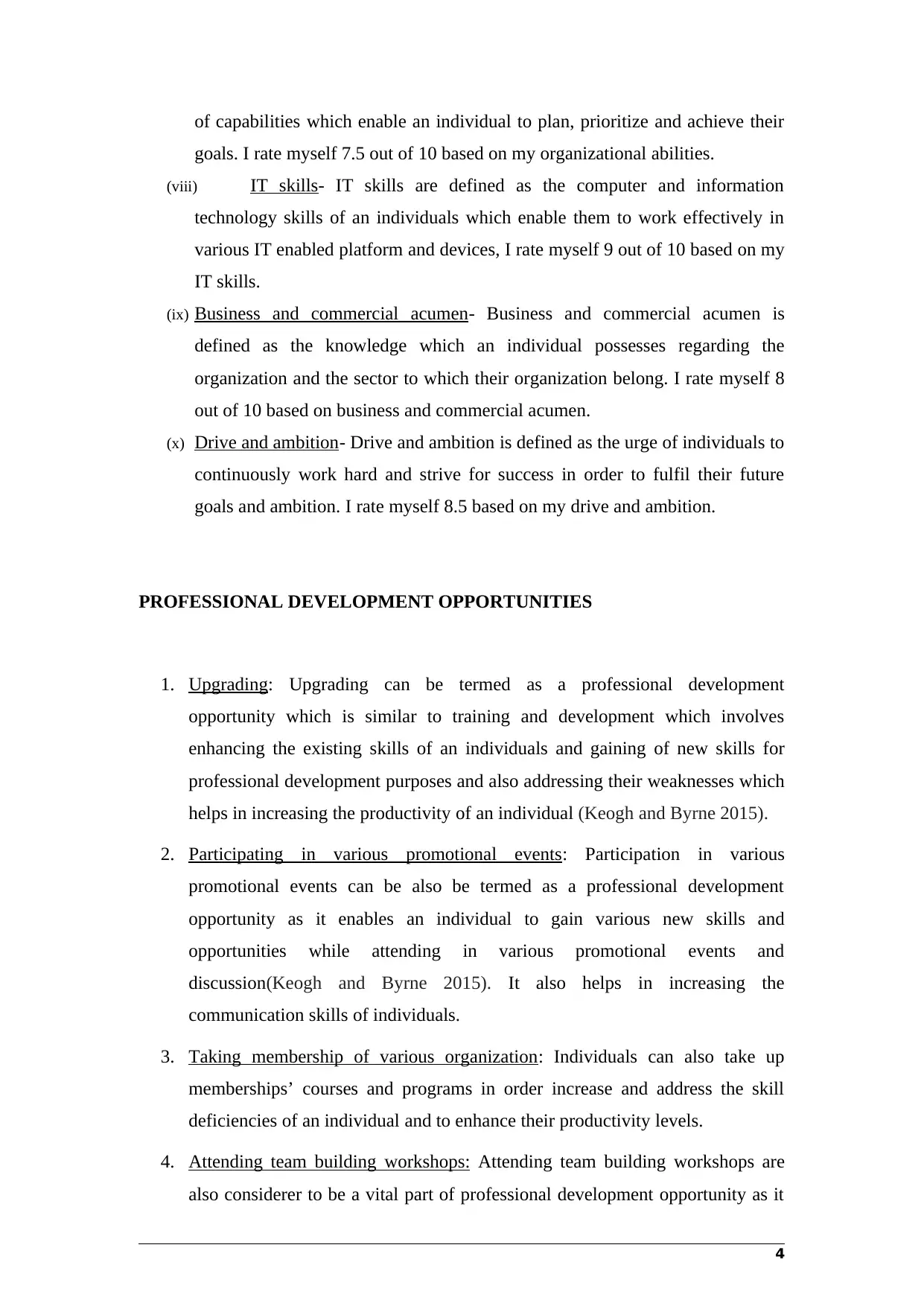
of capabilities which enable an individual to plan, prioritize and achieve their
goals. I rate myself 7.5 out of 10 based on my organizational abilities.
(viii) IT skills- IT skills are defined as the computer and information
technology skills of an individuals which enable them to work effectively in
various IT enabled platform and devices, I rate myself 9 out of 10 based on my
IT skills.
(ix) Business and commercial acumen- Business and commercial acumen is
defined as the knowledge which an individual possesses regarding the
organization and the sector to which their organization belong. I rate myself 8
out of 10 based on business and commercial acumen.
(x) Drive and ambition- Drive and ambition is defined as the urge of individuals to
continuously work hard and strive for success in order to fulfil their future
goals and ambition. I rate myself 8.5 based on my drive and ambition.
PROFESSIONAL DEVELOPMENT OPPORTUNITIES
1. Upgrading: Upgrading can be termed as a professional development
opportunity which is similar to training and development which involves
enhancing the existing skills of an individuals and gaining of new skills for
professional development purposes and also addressing their weaknesses which
helps in increasing the productivity of an individual (Keogh and Byrne 2015).
2. Participating in various promotional events: Participation in various
promotional events can be also be termed as a professional development
opportunity as it enables an individual to gain various new skills and
opportunities while attending in various promotional events and
discussion(Keogh and Byrne 2015). It also helps in increasing the
communication skills of individuals.
3. Taking membership of various organization: Individuals can also take up
memberships’ courses and programs in order increase and address the skill
deficiencies of an individual and to enhance their productivity levels.
4. Attending team building workshops: Attending team building workshops are
also considerer to be a vital part of professional development opportunity as it
4
goals. I rate myself 7.5 out of 10 based on my organizational abilities.
(viii) IT skills- IT skills are defined as the computer and information
technology skills of an individuals which enable them to work effectively in
various IT enabled platform and devices, I rate myself 9 out of 10 based on my
IT skills.
(ix) Business and commercial acumen- Business and commercial acumen is
defined as the knowledge which an individual possesses regarding the
organization and the sector to which their organization belong. I rate myself 8
out of 10 based on business and commercial acumen.
(x) Drive and ambition- Drive and ambition is defined as the urge of individuals to
continuously work hard and strive for success in order to fulfil their future
goals and ambition. I rate myself 8.5 based on my drive and ambition.
PROFESSIONAL DEVELOPMENT OPPORTUNITIES
1. Upgrading: Upgrading can be termed as a professional development
opportunity which is similar to training and development which involves
enhancing the existing skills of an individuals and gaining of new skills for
professional development purposes and also addressing their weaknesses which
helps in increasing the productivity of an individual (Keogh and Byrne 2015).
2. Participating in various promotional events: Participation in various
promotional events can be also be termed as a professional development
opportunity as it enables an individual to gain various new skills and
opportunities while attending in various promotional events and
discussion(Keogh and Byrne 2015). It also helps in increasing the
communication skills of individuals.
3. Taking membership of various organization: Individuals can also take up
memberships’ courses and programs in order increase and address the skill
deficiencies of an individual and to enhance their productivity levels.
4. Attending team building workshops: Attending team building workshops are
also considerer to be a vital part of professional development opportunity as it
4
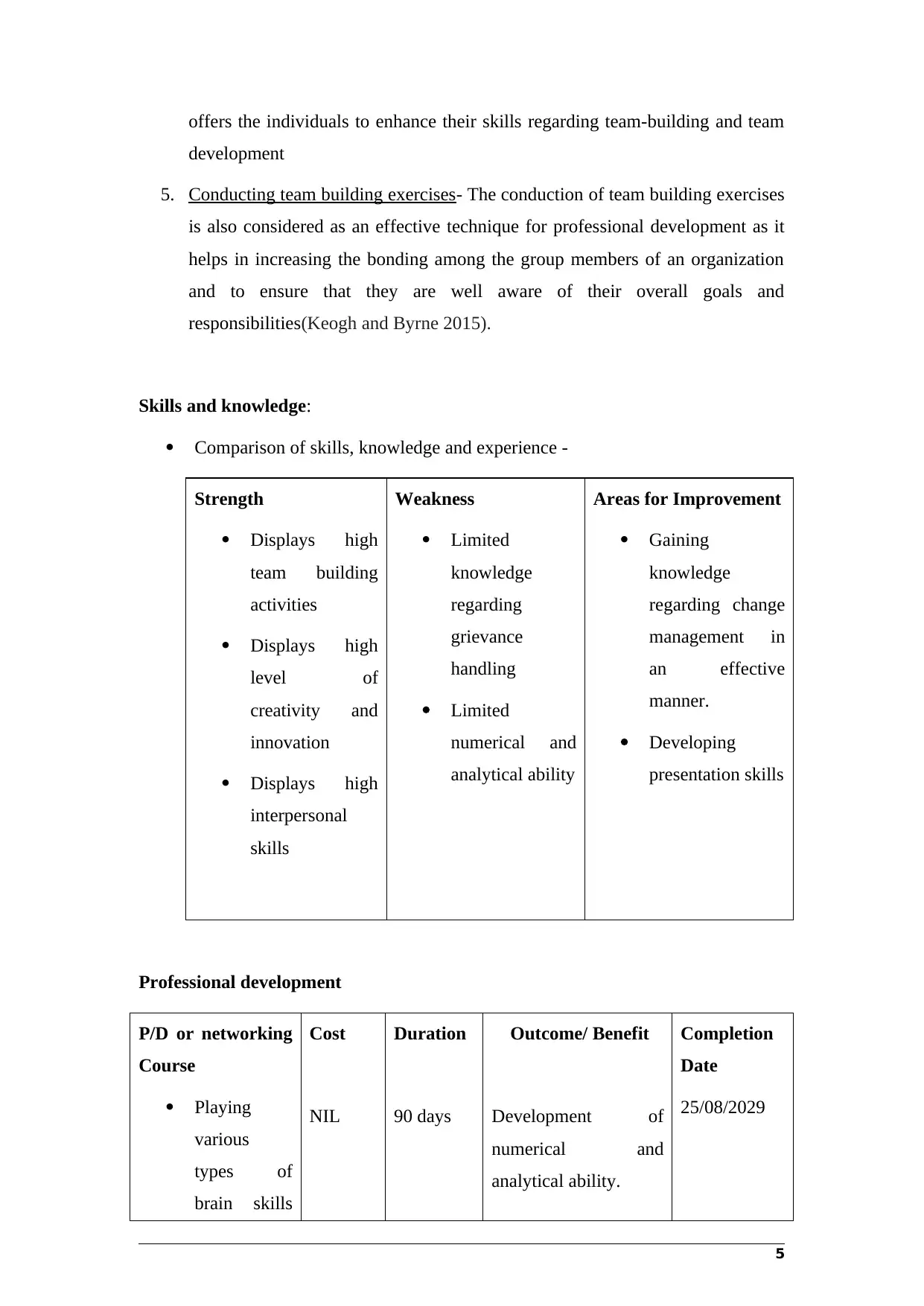
offers the individuals to enhance their skills regarding team-building and team
development
5. Conducting team building exercises- The conduction of team building exercises
is also considered as an effective technique for professional development as it
helps in increasing the bonding among the group members of an organization
and to ensure that they are well aware of their overall goals and
responsibilities(Keogh and Byrne 2015).
Skills and knowledge:
Comparison of skills, knowledge and experience -
Strength
Displays high
team building
activities
Displays high
level of
creativity and
innovation
Displays high
interpersonal
skills
Weakness
Limited
knowledge
regarding
grievance
handling
Limited
numerical and
analytical ability
Areas for Improvement
Gaining
knowledge
regarding change
management in
an effective
manner.
Developing
presentation skills
Professional development
P/D or networking
Course
Playing
various
types of
brain skills
Cost
NIL
Duration
90 days
Outcome/ Benefit
Development of
numerical and
analytical ability.
Completion
Date
25/08/2029
5
development
5. Conducting team building exercises- The conduction of team building exercises
is also considered as an effective technique for professional development as it
helps in increasing the bonding among the group members of an organization
and to ensure that they are well aware of their overall goals and
responsibilities(Keogh and Byrne 2015).
Skills and knowledge:
Comparison of skills, knowledge and experience -
Strength
Displays high
team building
activities
Displays high
level of
creativity and
innovation
Displays high
interpersonal
skills
Weakness
Limited
knowledge
regarding
grievance
handling
Limited
numerical and
analytical ability
Areas for Improvement
Gaining
knowledge
regarding change
management in
an effective
manner.
Developing
presentation skills
Professional development
P/D or networking
Course
Playing
various
types of
brain skills
Cost
NIL
Duration
90 days
Outcome/ Benefit
Development of
numerical and
analytical ability.
Completion
Date
25/08/2029
5
⊘ This is a preview!⊘
Do you want full access?
Subscribe today to unlock all pages.

Trusted by 1+ million students worldwide
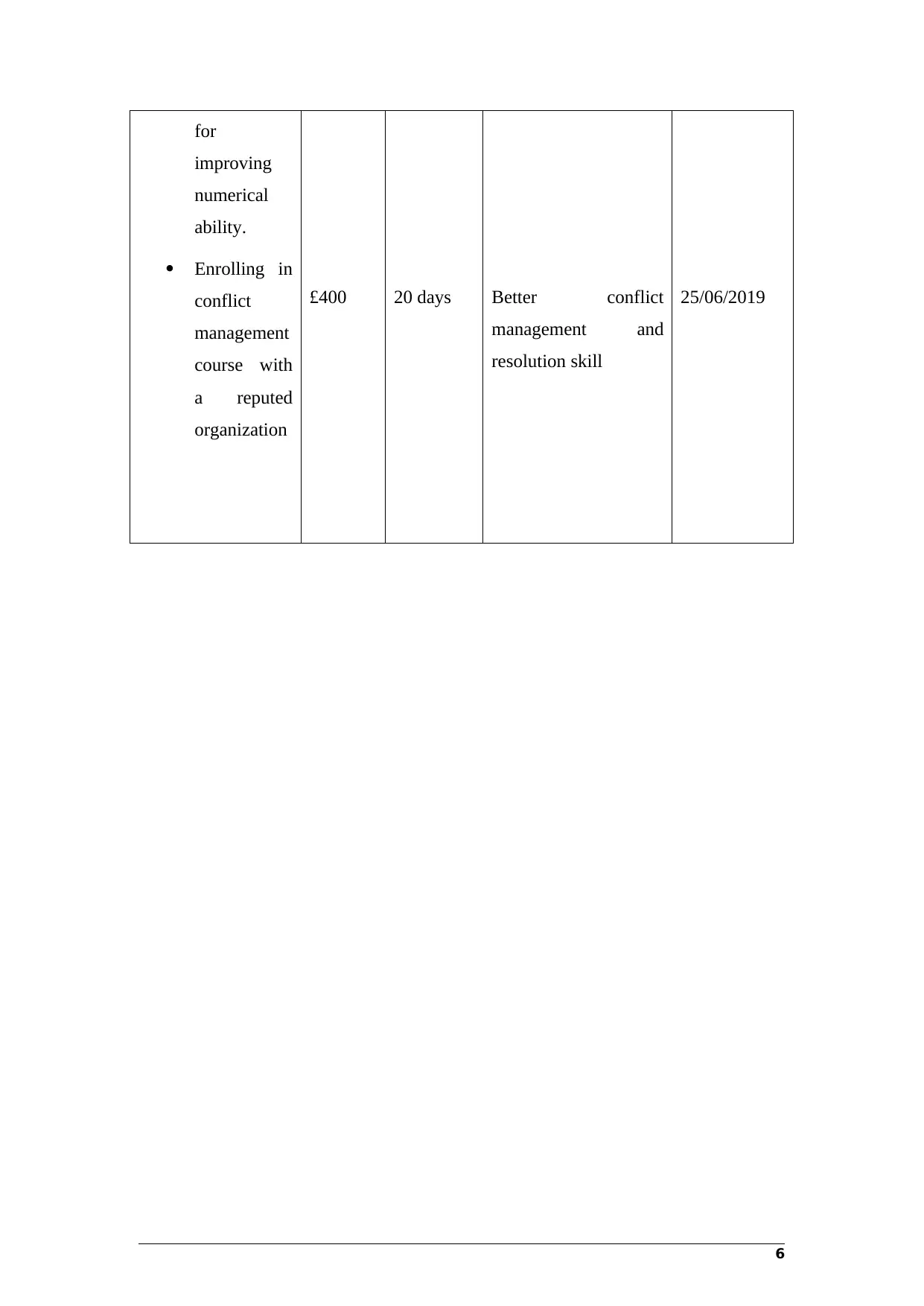
for
improving
numerical
ability.
Enrolling in
conflict
management
course with
a reputed
organization
£400 20 days Better conflict
management and
resolution skill
25/06/2019
6
improving
numerical
ability.
Enrolling in
conflict
management
course with
a reputed
organization
£400 20 days Better conflict
management and
resolution skill
25/06/2019
6
Paraphrase This Document
Need a fresh take? Get an instant paraphrase of this document with our AI Paraphraser
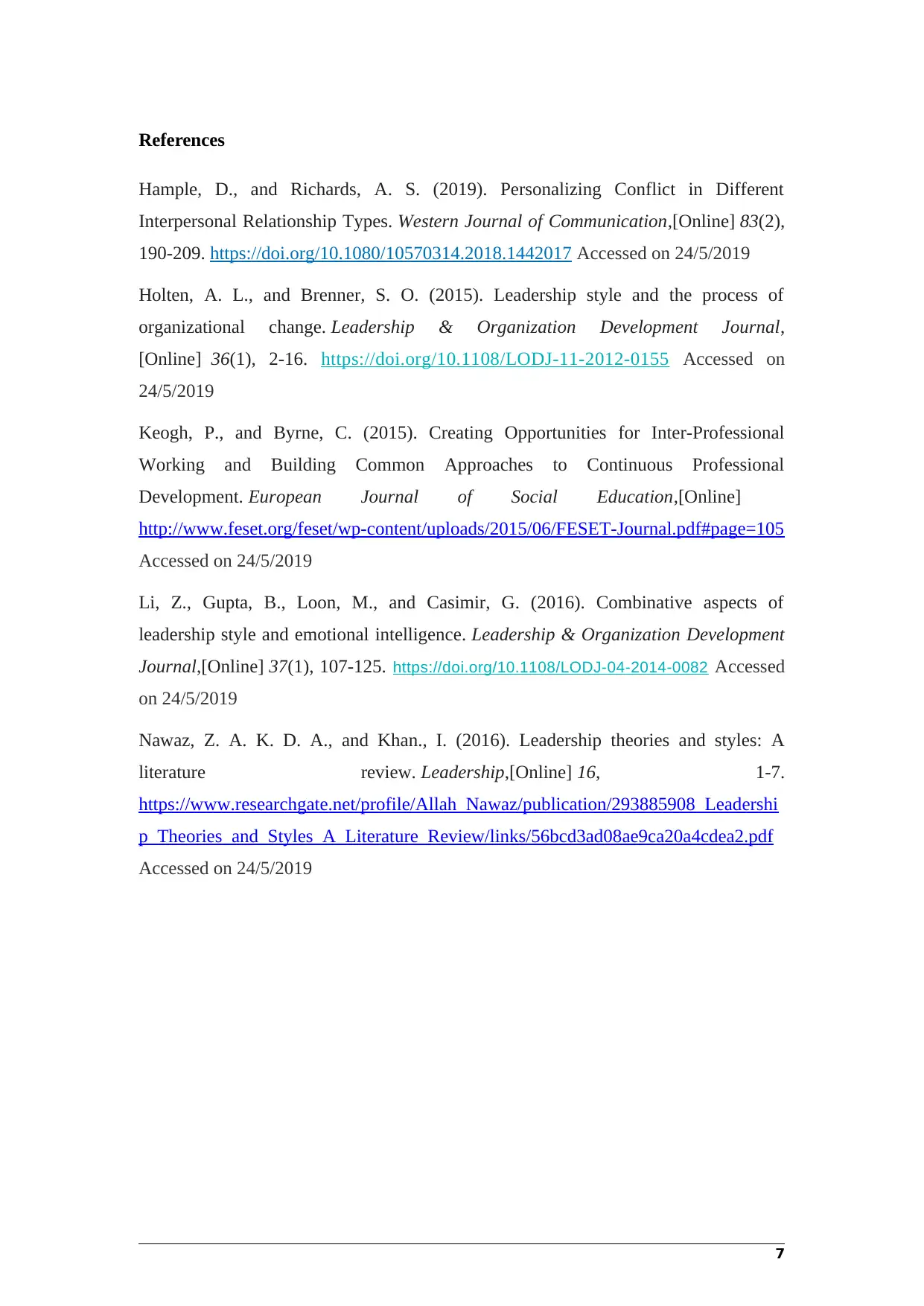
References
Hample, D., and Richards, A. S. (2019). Personalizing Conflict in Different
Interpersonal Relationship Types. Western Journal of Communication,[Online] 83(2),
190-209. https://doi.org/10.1080/10570314.2018.1442017 Accessed on 24/5/2019
Holten, A. L., and Brenner, S. O. (2015). Leadership style and the process of
organizational change. Leadership & Organization Development Journal,
[Online] 36(1), 2-16. https://doi.org/10.1108/LODJ-11-2012-0155 Accessed on
24/5/2019
Keogh, P., and Byrne, C. (2015). Creating Opportunities for Inter-Professional
Working and Building Common Approaches to Continuous Professional
Development. European Journal of Social Education,[Online]
http://www.feset.org/feset/wp-content/uploads/2015/06/FESET-Journal.pdf#page=105
Accessed on 24/5/2019
Li, Z., Gupta, B., Loon, M., and Casimir, G. (2016). Combinative aspects of
leadership style and emotional intelligence. Leadership & Organization Development
Journal,[Online] 37(1), 107-125. https://doi.org/10.1108/LODJ-04-2014-0082 Accessed
on 24/5/2019
Nawaz, Z. A. K. D. A., and Khan., I. (2016). Leadership theories and styles: A
literature review. Leadership,[Online] 16, 1-7.
https://www.researchgate.net/profile/Allah_Nawaz/publication/293885908_Leadershi
p_Theories_and_Styles_A_Literature_Review/links/56bcd3ad08ae9ca20a4cdea2.pdf
Accessed on 24/5/2019
7
Hample, D., and Richards, A. S. (2019). Personalizing Conflict in Different
Interpersonal Relationship Types. Western Journal of Communication,[Online] 83(2),
190-209. https://doi.org/10.1080/10570314.2018.1442017 Accessed on 24/5/2019
Holten, A. L., and Brenner, S. O. (2015). Leadership style and the process of
organizational change. Leadership & Organization Development Journal,
[Online] 36(1), 2-16. https://doi.org/10.1108/LODJ-11-2012-0155 Accessed on
24/5/2019
Keogh, P., and Byrne, C. (2015). Creating Opportunities for Inter-Professional
Working and Building Common Approaches to Continuous Professional
Development. European Journal of Social Education,[Online]
http://www.feset.org/feset/wp-content/uploads/2015/06/FESET-Journal.pdf#page=105
Accessed on 24/5/2019
Li, Z., Gupta, B., Loon, M., and Casimir, G. (2016). Combinative aspects of
leadership style and emotional intelligence. Leadership & Organization Development
Journal,[Online] 37(1), 107-125. https://doi.org/10.1108/LODJ-04-2014-0082 Accessed
on 24/5/2019
Nawaz, Z. A. K. D. A., and Khan., I. (2016). Leadership theories and styles: A
literature review. Leadership,[Online] 16, 1-7.
https://www.researchgate.net/profile/Allah_Nawaz/publication/293885908_Leadershi
p_Theories_and_Styles_A_Literature_Review/links/56bcd3ad08ae9ca20a4cdea2.pdf
Accessed on 24/5/2019
7
1 out of 8
Related Documents
Your All-in-One AI-Powered Toolkit for Academic Success.
+13062052269
info@desklib.com
Available 24*7 on WhatsApp / Email
![[object Object]](/_next/static/media/star-bottom.7253800d.svg)
Unlock your academic potential
Copyright © 2020–2025 A2Z Services. All Rights Reserved. Developed and managed by ZUCOL.




